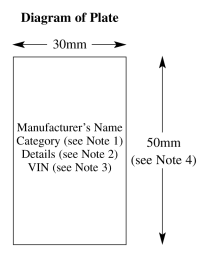(see regulation 82(2))
SCHEDULE 12Plates for Motor Cycles
1. The plate required by regulation 82(2) shall be firmly attached to a part of the motor cycle which is not normally subject to replacement during the life of the motor cycle.
2. The plate shall be in the form shown in the diagram below, shall have dimensions not less than those shown in that diagram and shall show the information provided for in that diagram and detailed in the Notes below.
Notes:
1. The categories are “standard motor cycle” and “moped”.
2. The details are—
(a)for standard motor cycles—
(i)the engine capacity,
(ii)the maximum engine power, and
(iii)the power to weight ratio,
provided that the details under (ii) and (iii) need not be shown for a vehicle first used before 1st January 1982;
(b)for mopeds—
(i)the engine capacity,
(ii)the kerbside weight, and
(iii)the maximum speed.
3. The vehicle identification number (VIN) shall be marked in the form used by the manufacturer to identify any one individual vehicle.
4. In the case of a plate fitted to a vehicle first used before 1st January 1982 or to a moped this dimension shall be 40mm.
5. The information on the plate shall be shown in characters not less than 4mm in height and in the positions on the plate indicated in the diagram.
6. No information, other than that provided for in the diagram, shall be marked within the rectangle which is shown in that diagram.
7. In this Schedule—
“maximum engine power” means the maximum net power the motor cycle engine will develop, in kilowatts, when measured in accordance with the test conditions specified in the International Standard number ISO 4106 developed by the technical committee of the International Organisation for Standardisation, and approved by member bodies, including the United Kingdom, and published under the reference ISO 1978 4106-09-01;
“moped” means a motor cycle which—
has a kerbside weight not exceeding 250 kg, and
if propelled by an internal combustion engine, has an engine with a cylinder capacity which does not exceed 50 cc, and
is designed to have a maximum speed not exceeding 30 mph when driven under the conditions set out in paragraph 8.
“power to weight ratio” means the ratio of the maximum engine power to the kerbside weight of the vehicle measured, as regards the maximum engine power, in kilowatts and, as regards the kerbside weight, in 1000 kg;
“standard motor cycle” means a motor cycle which is not a moped.
8. A motor cycle shall be regarded as complying with paragraph (c) of the definition of “moped” in paragraph 7 if it cannot exceed 35 mph when tested under the following conditions—
(a)the surface on which it is tested shall be dry asphalt or concrete;
(b)the rider shall be a person not exceeding 75 kg in weight;
(c)no passenger or load shall be carried;
(d)the test route shall be so located that acceleration to, and deceleration from, maximum speed can take place elsewhere than on the test route itself;
(e)the test route shall not have a gradient exceeding 5%;
(f)the motor cycle shall be ridden in opposite directions along the test route and the speed recorded for the purpose of the test shall (in order to minimise the effect of wind resistance and gradient) be the average of speeds shown for each direction;
(g)when being driven along the test route, the motor cycle shall be driven in such manner and in such gear as to achieve the maximum speed of which it is capable; and
(h)if the motor cycle is fitted with a device which can, without the use of specialist tools or equipment, be readily modified or removed so as to increase its maximum speed, the test shall be carried out with the device in the modified condition or, as the case may be, without the device.

